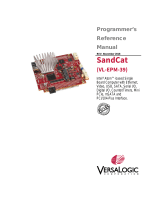
iv
MC68SC302 USER’S MANUAL
UNITED STATES
ALABAMA
, Huntsville (205) 464-6800
ARIZONA
, Tempe (602) 897-5056
CALIFORNIA
, Agoura Hills (818) 706-1929
CALIFORNIA
, Los Angeles (310) 417-8848
CALIFORNIA
, Irvine (714) 753-7360
CALIFORNIA
, Rosevllle (916) 922-7152
CALIFORNIA
, San Diego (619) 541-2163
CALIFORNIA
, Sunnyvale (408) 749-0510
COLORADO
, Colorado Springs (719) 599-7497
COLORADO
, Denver (303) 337-3434
CONNECTICUT
, Wallingford (203) 949-4100
FLORIDA
, Maitland (407) 628-2636
FLORIDA
, Pompano Beach/
Fort Lauderdal (305) 486-9776
FLORIDA
, Clearwater (813) 538-7750
GEORGlA
, Atlanta (404) 729-7100
IDAHO
, Boise (208) 323-9413
ILLINOIS
, Chicago/Hoffman Estates (708) 490-9500
INDlANA
, Fort Wayne (219) 436-5818
INDIANA
, Indianapolis (317) 571-0400
INDIANA
, Kokomo (317) 457-6634
IOWA
, Cedar Rapids (319) 373-1328
KANSAS
, Kansas City/Mission (913) 451-8555
MARYLAND
, Columbia (410) 381-1570
MASSACHUSETTS
, Marborough (508) 481-8100
MASSACHUSETTS
, Woburn (617) 932-9700
MICHIGAN
, Detroit (313) 347-6800
MINNESOTA
, Minnetonka (612) 932-1500
MISSOURI
, St. Louis (314) 275-7380
NEW JERSEY
, Fairfield (201) 808-2400
NEW YORK
, Fairport (716) 425-4000
NEW YORK
, Hauppauge (516) 361-7000
NEW YORK
, Poughkeepsie/Fishkill (914) 473-8102
NORTH CAROLINA
, Raleigh (919) 870-4355
OHIO
, Cleveland (216) 349-3100
OHIO
, Columbus Worthington (614) 431-8492
OHIO
, Dayton (513) 495-6800
OKLAHOMA
, Tulsa (800) 544-9496
OREGON
, Portland (503) 641-3681
PENNSYLVANIA
, Colmar (215) 997-1020
Philadelphia/Horsham (215) 957-4100
TENNESSEE
, Knoxville (615) 690-5593
TEXAS
, Austin (512) 873-2000
TEXAS
, Houston (800) 343-2692
TEXAS
, Plano (214) 516-5100
VIRGINIA
, Richmond (804) 285-2100
WASHINGTON
, Bellevue (206) 454-4160
Seattle Access (206) 622-9960
WISCONSIN
, Milwaukee/Brookfield (414) 792-0122
CANADA
BRITISH COLUMBIA
, Vancouver (604) 293-7605
ONTARIO
, Toronto (416) 497-8181
ONTARIO
, Ottawa (613) 226-3491
QUEBEC
, Montreal (514) 731-6881
INTERNATIONAL
AUSTRALIA
, Melbourne (61-3)887-0711
AUSTRALIA
, Sydney (61(2)906-3855
BRAZIL
, Sao Paulo 55(11)815-4200
CHINA
, Beijing 86 505-2180
FINLAND
, Helsinki 358-0-35161191
Car Phone 358(49)211501
FRANCE
, Paris/Vanves 33(1)40 955 900
GERMANY
, Langenhagen/ Hanover 49(511)789911
GERMANY
, Munich 49 89 92103-0
GERMANY
, Nuremberg 49 911 64-3044
GERMANY
, Sindelfingen 49 7031 69 910
GERMANY
,Wiesbaden 49 611 761921
HONG KONG
, Kwai Fong 852-4808333
Tai Po 852-6668333
INDIA
, Bangalore (91-812)627094
ISRAEL
, Tel Aviv 972(3)753-8222
ITALY
, Milan 39(2)82201
JAPAN
, Aizu 81(241)272231
JAPAN
, Atsugi 81(0462)23-0761
JAPAN
, Kumagaya 81(0485)26-2600
JAPAN
, Kyushu 81(092)771-4212
JAPAN
, Mito 81(0292)26-2340
JAPAN
, Nagoya 81(052)232-1621
JAPAN
, Osaka 81(06)305-1801
JAPAN,
Sendai 81(22)268-4333
JAPAN,
Tachikawa 81(0425)23-6700
JAPAN,
Tokyo 81(03)3440-3311
JAPAN
, Yokohama 81(045)472-2751
KOREA
, Pusan 82(51)4635-035
KOREA
, Seoul 82(2)554-5188
MALAYSIA
, Penang 60(4)374514
MEXICO
, Mexico City 52(5)282-2864
MEXICO
, Guadalajara 52(36)21-8977
Marketing 52(36)21-9023
Customer Service 52(36)669-9160
NETHERLANDS
, Best (31)49988 612 11
PUERTO RICO
, San Juan (809)793-2170
SINGAPORE
(65)2945438
SPAIN
, Madrid 34(1)457-8204
or 34(1)457-8254
SWEDEN
, Solna 46(8)734-8800
SWITZERLAND
, Geneva 41(22)7991111
SWITZERLAND
, Zurich 41(1)730 4074
TAlWAN
, Taipei 886(2)717-7089
THAILAND
, Bangkok (66-2)254-4910
UNITED KINGDOM, Aylesbury 44(296)395-252
FULL LINE REPRESENTATIVES
COLORADO, Grand Junction
Cheryl Lee Whltely (303) 243-9658
KANSAS, Wichita
Melinda Shores/Kelly Greiving (316) 838 0190
NEVADA, Reno
Galena Technology Group (702) 746 0642
NEW MEXICO, Albuquerque
S&S Technologies, lnc. (505) 298-7177
UTAH, Salt Lake City
Utah Component Sales, Inc. (801) 561-5099
WASHINGTON, Spokane
Doug Kenley (509) 924-2322
ARGENTINA, Buenos Aires
Argonics, S.A. (541) 343-1787
HYBRID COMPONENTS RESELLERS
Elmo Semiconductor (818) 768-7400
Minco Technology Labs Inc. (512) 834-2022
Semi Dice Inc. (310) 594-4631
Fr
ees
cale S
em
iconduct
or
, I
Freescale Semiconductor, Inc.
For More Information On This Product,
Go to: www.freescale.com
nc...




















